Text
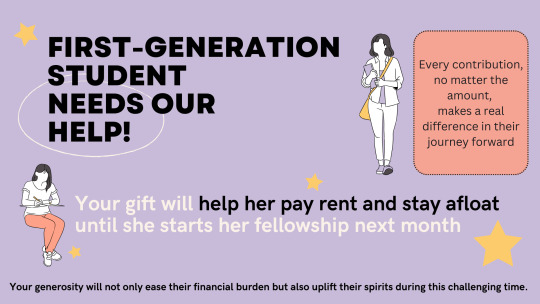
Community, we need your help!
Due to health complications, this first-generation student is in need of a little extra support to stay afloat until they start their new job next month.
We're aiming to raise $1600 ASAP to cover past-due rent and an additional $2000 for this month's rent and bills. Every single contribution, big or small, makes a real difference in their journey forward.
Let's show them the power of community support! Your generosity will not only ease their financial burden but also uplift their spirits during this challenging time.
Donations can be made via this givebutter fundraiser. Or, you can reach out to me directly to donate via paypal or venmo to avoid transaction fees.
Thank you!!!
#mutual aid#fundraiser#first generation#indigenous#rent relief#signal boost#givebutter#resilience#medical debt#indigenous resilience
2 notes
·
View notes
Photo

Couple weeks ago, an #Uchinaanchu cousin from #Brazil contacted me after finding me as a DNA match. How awesome we got to "meet" last week via Zoom.
When I got my brother to take a DNA test few years ago to aid in genealogy research of our dad’s / American family, I definitely wasnʻt expecting anyone on my mom’s / Uchinaanchu side of family to show up as matches. But Iʻve been pleasantly surprised by the #Shimanchu cousins Iʻm encountering across the #diaspora.
As I've sifted through various documents and ships’ manifests in search of possible relatives that connect us cousins, I've come across descriptions like those pictured here, which made my heart race as I felt something tug at it and my eyes widen:
"Tattoo marks on back of 2nd and 3rd finger of both hands."
"Tattoo marks on backs of all fingers of both hands..."
Hajichi.
I could almost picture their hands blessed with #hajichi, holding so many stories past/present/future - connecting their lives in Ryukyu islands and journey to new shores with our present and collective memories and all our connected roots in our beloved ʻnmarijima, across #LooChoo.
This manifest is filled with pages of passenger names almost entirely young Uchinaanchu arriving as “farm workers.”
These Shimanchu arrived in Hawai'i as #ImmigrantFarmworkers or traveled on to Mexico, US, Peru, Brazil, Argentina... Many were recruited with promises of guaranteed work, steady pay, and in some cases land or free lodging. Many would discover otherwise upon their arrivals.
My cousins are here now reaching out to each other because somehow the passengers of this ship and others that passed through these ports found ways to persevere. It is important we do our part to remember and learn from them, even if we must dig a little together now to do so.
Whenever I review ship manifests and immigration documents, I often wonder what folks thought and felt as their new home could be seen on the horizon and their future came more clearly into view...
This time, I found myself drawn to the image of these hands... what must they have carried with them on this journey?
#uchinaanchu#brazil#shimanchu#diaspora#hajichi#loochoo#immigrantfarmworkers#imigração#okinawanos#brasil#imigrantes#história#memória
74 notes
·
View notes
Video
In less than a week, Iʻll be completing another spin around the sun. All I want for my birthday is for the Japanese government to respect the democratic will of #Shimanchu (#indigenous #Okinawans / #Ryukyuans).
A step in the right direction would be putting a stop to the excavation of WWII remains (including not only thousands of Okinawans but also American soldiers, Japanese soldiers, Koreans, etc) and the desecration of our ancestorsʻ bones to build yet another US military base in Okinawa.
So, the best way to wish me a happy birthday is to let Japan know that you support the wishes of the people of Okinawa.
Hereʻs one quick, easy way you can do just that: http://chng.it/FPM7F45bMM ✍🏼 Please sign and share! 🙏🏼🙇🏻♀️
#dontkilltwice
Link is in bio. Petition is in 日本語 / Español / Português / English
#LooChoo #Uchinaanchu #ProtectTheSacred
#Shimanchu#Ryukyuans#Okinawans#LooChoo#Ryukyu#indigenous#Okinawa#DontKillTwice#Uchinaanchu#ProtectTheSacred#demilitarize#decolonize#World War 2#WWII#Battle of Okinawa#Typhoon of Steel#indigenousresilience#Japan#desecration#indigenous rights#bones#ancestors#sacred#沖縄戦#tetsu no ame#tetsu no bofu#Operation Iceberg#missing in action#BringThemHome#RiseForHenoko
1 note
·
View note
Video
youtube
First, lemme say, as malihini (foreigner, guest) in Hawai'i nei, to learn ʻōlelo Hawaiʻi is our kuleana (both privilege+responsibility). Given the history and ongoing illegal occupation, learning even just a little ʻōlelo and doing our part to renormalize its day-to-day use is the least - and I do mean the bare minimum - I or anyone else visiting as tourist or living on this 'āina can do. And it should be done with respect for nā kānaka oiwi, their culture, and their ʻāina as language is not separate of these things.
I am no expert and clearly I still have a lot to learn and need all the help I can get, but if anyone else is eager to learn too, I'm happy to share some of the resources others have shared with me to supplement my online classes. Many are free and available online!
Now, having said that, e kala mai! Please don't take this as an invitation to roast me but if you're kānaka and/or nā po'e ʻōlelo Hawaiʻi, please do feel free to offer feedback! I am always eager to learn and practice with others!! I am truly humbled by the opportunity to do so.
For context, some friends and I were hoping to meet up via zoom last night to study and practice ʻŌlelo Hawaiʻi together. We are trying to meet up regularly to practice and encourage each other. Our goal for this week was to polish our ho'olauna (introductions). Unfortunately, we had to cancel/reschedule. But I've challenged myself to practice speaking every day (and not just practice my reading/writing comprehension), even if itʻs just for a few minutes. So.....
I recorded myself practicing and ya'll get to be my accountability buddies this time.
I've been learning 'Ōlelo Hawaiʻi online since this summer. One challenge I face no matter what language I speak (even English) is overcoming my social anxieties. I often freeze and/or nervously fumble over my words, particularly in group settings. Of course, this increases the less familiar I am with the language and/or culture. What fun! Aaaand Zoom classes tend to bump the dial up several notches and send my anxiety soaring through the roof. The emotional landscape of the state of the world certainly doesnʻt help either! So, Iʻm trying to make concerted efforts outside of class to help me lean into the challenges of learning online and my own discomfort. So, here we are...
Please note, this isn't my formal or more traditional ho'olauna but this is my effort to stretch and try to finds ways to speak to some of the many questions that often come up whenever I have to introduce myself, particularly when it comes to where I am "from"...
Spoiler alert: I am a multi-ethnic Shimanchu, born on the island of Uchinaa but raised in the diaspora. You can call me Okinawan / Uchinaanchu or Ryukyuan / LooChooan but please know that I am NOT Japanese. Being given Japanese citizenship at birth does not erase the violent overthrow of our Kingdom and ongoing illegal occupation of the Loo Choo islands. No matter how much the Japanese government has tried to kill and/or beat or erase Shimanchu and the rich history and culture of the Loo Choo Kingdom, they cannot take away the blood that runs through my veins and the pride I hold in my heart for all of the gifts and lessons my ancestors have passed down to me.
Also, much like trying to learn my own heritage languages like Uchinaaguchi or Chahta Anumpa, it can be challenging to find folks who are both willing and able to practice indigenous languages, thanks to colonialism and the intergenerational trauma and institutional erasure or other barriers it creates/created. But I have been truly inspired by innovative and empowering ways indigenous brothers/sisters/siblings across the globe are leveraging technology to heal, connect, and overcome these hurdles, especially during these times of social distancing. (I mean, have yʻall been on TikTok??) So, here's my attempt to use technology to break down some of these barriers while also confronting some of my fears.
Who knows...maybe itʻll inspire someone else to tackle some of your own fears, transform the way you think about technology, ....or perhaps (hopefully!) it'll make you pause to think about our individual and collective responsibility to decolonize ourselves and our communities and to honor the lands we call home - and the indigenous / aboriginal / First Nations peoples of the lands where we live - wherever in the world we find ourselves. (OK, gonna stop there for now before I start ranting about Asian Settler Colonialism, but consider this me lovingly calling in all Shimanchu here in Hawaiʻi to join me...)
OK. One minute challenge. Here we go!! *deep breaths*
#ʻolelo Hawaiʻi#hoʻolauna#hoʻomaʻamaʻa#e ola ka ʻōlelo#eolakaolelohawaii#Loo Choo#Ryukyu#Uchinaanchu#decolonize#indigenize#language endangerment#endangered language#language revitalization#choctaw#chahta anumpa#kuleana#sukubun#LearningInTheTimeOfCovid#TikTok#olelohawaii#LooChoo#Shimanchu#indigenous#renormalization
3 notes
·
View notes
Photo
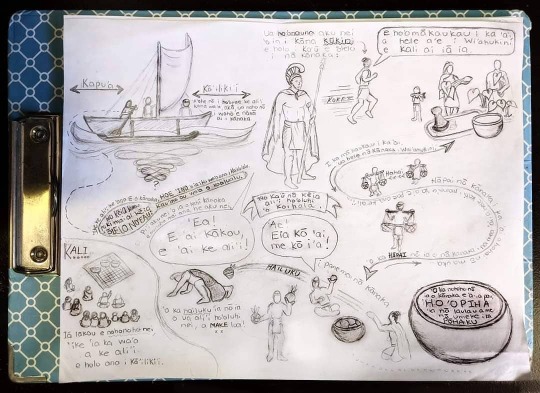
E kala mai. ʻAʻole au kahakiʻi maikaʻi loa, akā puni au i ke kahakiʻi naʻe. I koʻu hoʻopaʻa haʻawina ʻana i nā huaʻōlelo hou, kaha au nā kiʻi. Kahakiʻi hoʻi au i ka heluhelu ʻana nā moʻolelo. Ua kahakiʻi au i kēia mau kiʻi i kēlā hopena pule aku nei. Ua ho'olono/heluhelu hoʻi ʻoukou i kēia moʻolelo? Sorry. I donʻt draw very well, but I like to draw nonetheless. As I study new words, I sketch illustrations. I also draw as I read stories. I drew these pictures last weekend. Have yʻall heard/read this story? https://www.instagram.com/p/CFNRDO5BMzA/?igshid=6c3v57yhmb1
0 notes
Photo
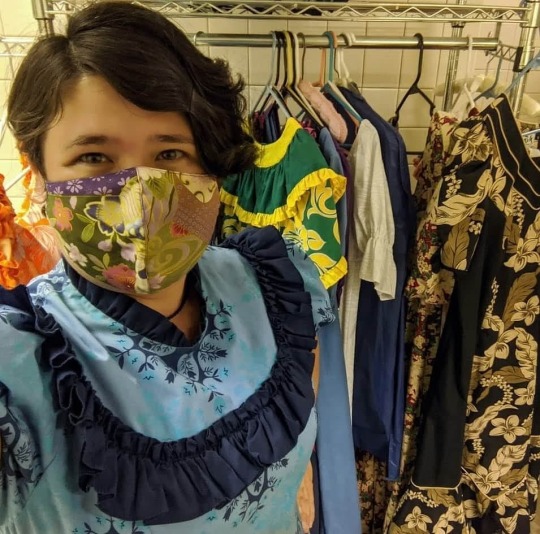
So, uhhh.. what do you think about my new look? It's not really my style to rock a mu'umu'u, but I'm stoked about the opportunity to volunteer and support such an important and beloved place here in Hawai'i nei. If you're nice and promise to remain out of punching distance (ie stay 6+ feet away), I might consider letting ya know when / where you can see me debut this new look! #YouCantPayMeToDressLikeThis #KeKōkuaNei (at Oahu, Hawaii) https://www.instagram.com/p/CDDKC7vBGS8/?igshid=6hwdbnnoezr3
2 notes
·
View notes
Photo

"He haumana 'ōlelo Hawai'i au!"
Today is the last day of UHʻs first summer session. Itʻs been intense, but also super rewarding.
Iʻm about to put the finishing touches on my final for ʻŌlelo Hawaiʻi - an audio-visual presentation as I introduce my ʻohana. So many feelings have bubbled up as I delve into studying another endangered language, jeopardized by colonialism and ongoing occupation as is the case by in my beloved 'nmarijima of Loo Choo / #Uchinaa / "Okinawa".... My heart aches but also....each word we speak brings life and gives me renewed hope. It is also ever humbling and inspiring as #Shimanchu / #Uchinaanchu living in Hawai'i to be able to learn from kanaka maoli here in Hawai'i.
Thanks to our AMAZING kumu, sign-language and illustrations have replaced the traditional flash cards I typically create with my other language studies... Itʻs proven to be pretty effective strategy to help me begin to "think" in the language rather than simply try to recall the English meaning.
For those whoʻve been curious, hereʻs a glimpse...
huaʻōlelo hou: moe
example usage:
ʻIke ʻo Kūkahauʻula iā Poliʻahu. Ua moe ʻo Kūkahauʻula i lalo, no ka mea, kapu ʻo Poliʻahu.
#VisualCues#KineticLearning#EmbodiesLearning#SchoolInTheTimeOfCovid19#ʻŌleloHawaii#ʻōlelo#ʻōlelo hou#Maunakea#Kukahauʻula#Poliʻahu#kapu#moe#Second Language Studies#Endangered Language#Language Revitalization#Uchinaanchu#Shimanchu#Hawaii#illustration#activartist
3 notes
·
View notes
Photo
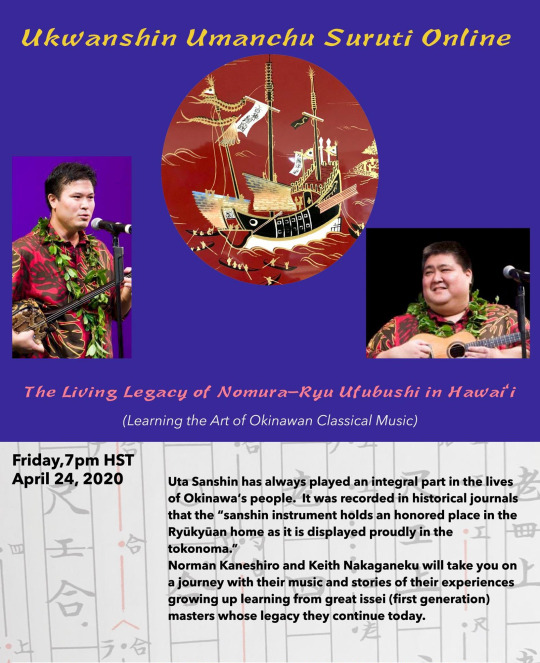
Ukwanshin Kabudan continues its Umanchu Suruti Online series. Next presentation is this Friday, April 24, 2020, from 7pm HST. We will be hearing from Norman Kaneshiro shinshii and Keith Nakaganeku shinshii regarding their experiences learning classical sanshin from issei masters.
It is both an honor and a pleasure to be one of their current students. As such, I am looking forward to this presentation and hope many fellow Shimanchu will join us. It has been amazing to have many Shimanchu / Uchinaanchu from all across the world joining us and we look forward to seeing friends new and old joining us again for this presentation!
For more info about Friday or this ongoing series, please follow Ukwanshin on their facebook page or feel free to message me for the link to join us on Zoom.
...
Ukwanshin Umanchu Suruti Online
Friday, April 24, 2020
7pm HST
The Living Legacy of Nomura-Ryu Ufubushi in Hawai’i
(Learning the Art of Okinawan Classical Music)
Uta Sanshin has always played an integral part in the lives of Okinawa’s people. It was recorded in historical journals that the “sanshin instrument holds an honored place in the Ryuukyuuan home as it is displayed proudly in the tokonoma.” Norman Kaneshiro and Keith Nakaganeku will take you on a journey with their music and stories of their experiences growing up learning from great issei (first generation) masters whose legacy they continue today.
#Shimanchu#Uchinaanchu#Okinawa#Ryukyu#Nomura-Ryu#Ufubushi#Hawaii nu Uchinaanchu#diaspora#indigenous#Loo Choo#Ukwanshin Kabudan#Umanchu Suruti#Uta-Sanshin#sanshin#issei#music#Uta#Koten
2 notes
·
View notes
Text
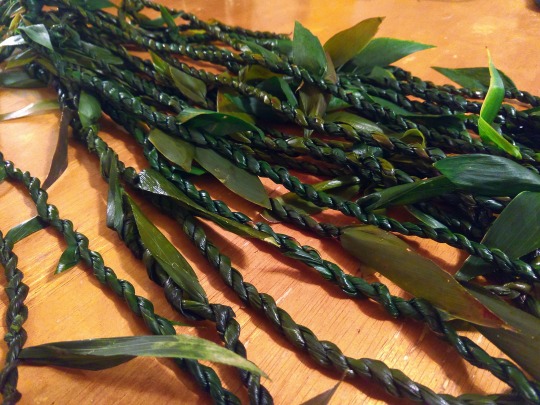
As Lunar New Year festivities continue, I spent the weekend enjoying continuation of new traditions too:
Welcoming group of visiting High School students from across Okinawa / Ryukyu Islands who are visiting Hawai'i for a Geijutsu / performing arts cultural exchange program!
Excited for them and the opportunity for all involved to reflect on what it means to be Shimanchu, what our ancestral sukubun / kuleana is to our precious land, water, traditions, and to each other.
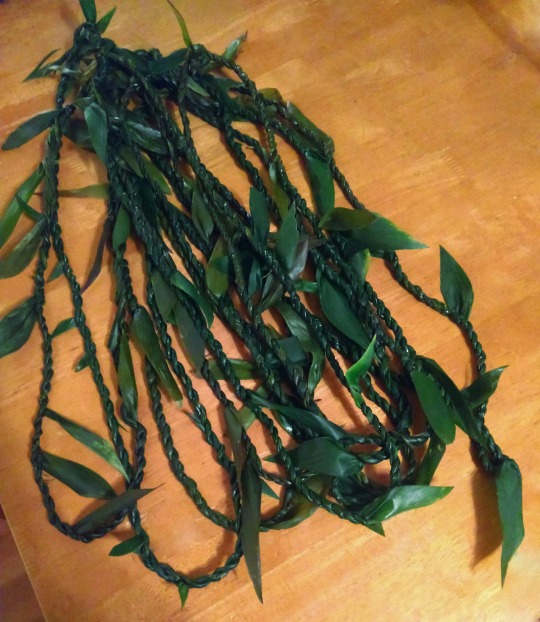
Spent time reflecting on this as I prepped the leaves and when meeting up with my shinshii and some classmates from Uchinaa Udui to braid lei la'i to welcome these visiting students. As we combined our harvested ti leaves to create these braids - twisting each piece with the next and combining to create something more beautiful and stronger than any one piece - I smiled about the multiple layers of metaphor there...
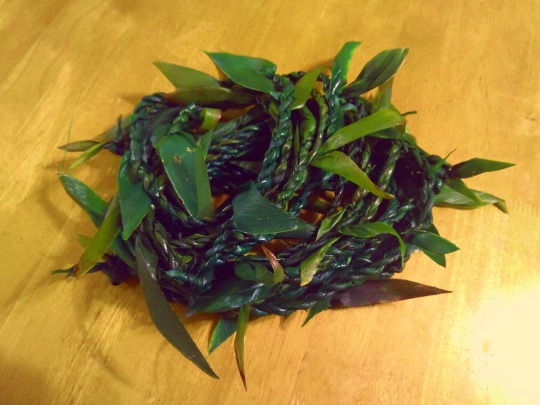
#Uchinaa#uchinaanchu#traditions#sukubun#kuleana#lei#ki#LeiLai#ti#cord#sacred#NaturesBlessings#Shimanchu#Okinawa#diaspora#geijutsu
28 notes
·
View notes
Photo
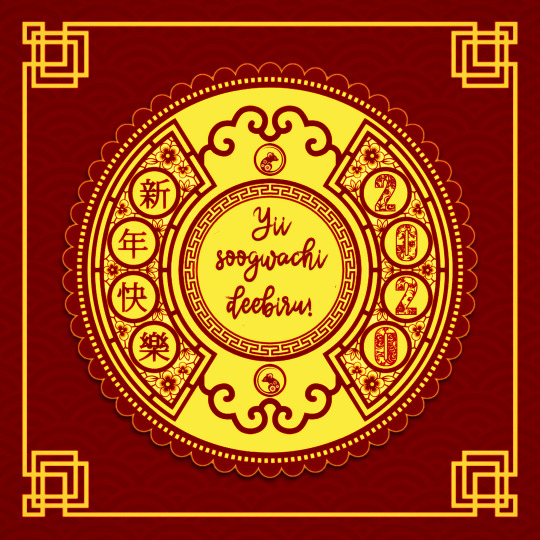
🐗 See you later, pig. Hello rat! 🐭
To all who celebrate, including yaaninju (family) and dushi nu chaa (friends) back in Uchinaa / Okinawa and our Shimanchu diaspora all across the globe:
🐉 Happy Lunar New Year !!! 🐲
Yii soogwachi deebiru! 🐀
いい正月 (そーぐゎち) でーびる!
¡Feliz año nuevo!
Feliz ano novo!
💮🌸Kutushin yutasarugutu unigee sabira! 🌸💮
明けましておめでとうございます!
今年もよろしくお願いいたします。
p.s. Wakaku naimisoochii. Did you get younger?
#恭禧發財#UchinaaSoogwachi#NotJustChineseNewYear#Uchinaanchu#LNY#OkinawanNewYear#いいそーぐゎちでーびる#YearOfTheRat#year of the metal rat#Happy New Year#WakakuNaimisoochii#traditions#yaaninju#Okinawa#Loochoo#Ryukyu#Lunar Calendar#diaspora#activartist
12 notes
·
View notes
Photo

What is something new you've recently tried or learned?
Me? Check it out! Another instrument followed me home this week...
Say hello to the Zhonghu (中胡) which I'll be learning to play in this semester's Chinese ensemble as we're introduced to Silk and Bamboo music (江南絲竹 Jiangnan Sizhu).
Zhonghu is an alto version of an Erhu (二胡), a 2 spike fiddle from the Huqin family. I’ll also pick up the Gaohu (高胡) as our class explores Cantonese ensemble music from Guangdong Province.
So, my sanshin has a new friend! (They’re cousins, I suppose.) Let's hope we all get along!!! 😅

As ridiculous as it is to add this class to my current schedule or to think that someone like me would go anywhere near another instrument, there were several reasons that drew me to consider this unique opportunity, including my own family’s relationship to China. And, as some of you know, my decision to follow the path that led me here to Hawai'i meant making promises about leaning into challenges and embracing opportunities to stretch and grow beyond my comfort zone.
So, here we are...
Ultimately, as much as they challenge me and force me to confront many of my anxieties, I find the opportunity to study music and dance is a regenerative experience and adds so much dimension to both what and how I learn. And despite how stressful performance is for me, these are also spaces where it feels I can show up as my whole self and connect with others in ways I've not experienced with anything else, even through my work as a visual artist. And if you know anything about what my experiences have been navigating academia, you know I need all the love balm, authentic connection, and cognitive armor I can get to survive...I think we all do, but I’ve been feeling this especially as I continue to be nudged to pursue a masters or PhD and/or return to teaching!
The ethnomusicology classes here (and, for that matter, my Second Language Studies) are like an antidote for those toxic environments where professors openly admit they teach about Okinawa because their goal is to turn us into tourists, professors who avoid acknowledging Loochoo / Okinawan indigeneity also cavalierly use "Eskimo" when speaking about Inuit and non-Inuit alike, and white men are positioned as authorities on our cultures and identities even when they answer students' questions and refute our lived experiences by saying things like, "Well, no, I'm married to a Japanese woman, and I've never heard that before..." etc...
I could go on, but I don't mean for this to become simply a rant about the need to decolonize /and indigenize academia. And yet, these feelings and the fatigue that stems from wading through that on a perpetual basis are related to why I'm so grateful for the dance and music classes I have opportunity to take and the practitioners sharing their amazing skills and knowledge of their own cultures with incredible graciousness, self-awareness, passion, and patience.
Anyway, now that I've shared some of the fear, excitement, and gratitude of bringing home another instrument, I leave you with a few more questions to ponder...
What is something you do every day / week that is healing or restorative? What led you to incorporate this as a regular practice?
Is there something you struggle with or might feel you're not good at but love to do? Is there something you used to enjoy but stopped doing because you thought you would never be great at it? What do/did you love about it?
What's something you've recently done in an effort to #decolonize your day-to-day life / your community?
#TrySomethingNewEveryDay#DecolonizationIsAProcess#Decolonize#IndigenizeEducation#IndigenousKnowledge#Ryukyu#Loochoo#ethnomusicology#SelfCare#ArtTherapy#okinawa#gratitude#anxiety#fear
3 notes
·
View notes
Photo
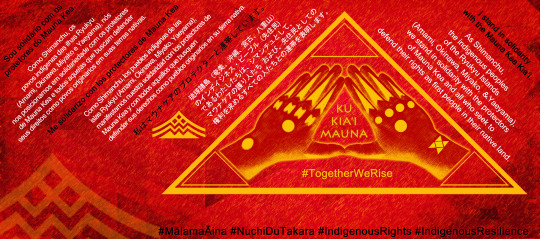
I stand in solidarity with Mauna Kea Kia’i.
私はマウナケアのプロテクターと連帯しています。
Me solidarizo con los protectores de Mauna Kea.
Sou solidário com os protetores do Mauna Kea.
As Shimanchu, the indigenous peoples of the Ryukyu Islands (Amami, Okinawa, Miyako, and Yaeyama), we stand in solidarity with the protectors of Mauna Kea and all who seek to defend their rights as first people in their native land.
Mauna Kea: Lā 168, Oura Bay: Day 2000
Today - December 27, 2019 - is Lā 168 for the Mauna Kea Kia'i here in Hawai'i & the 2000th day of continuous sit-ins for protectors of Henoko's Oura Bay, back in the Ryukyu islands (what is known today as “Okinawa”) - my place of birth and maternal ancestral homeland.
To pause and reflect on what this means and the parallels of the histories of these islands and our resilience in the face of both physical and cultural genocide is something I find to be bittersweet...
Together, we rise!
I created this image as I reflected upon the continuous work being done and sacrifices being made by brave and fiercely loving Kia'i / protectors - day in and out - embracing their ancestral sukubun / kuleana to protect our precious land, water, and all life.
It breaks my heart that we must do so; in fact, this was quickly pulled together earlier this week when Kia'i at Mauna Kea were bracing under threat of impending arrests, before the current moratorium was negotiated. And yet, despite the twinge of sorrow in why we must fight for our indigenous rights, for our right to self-determination, and for the protection of our lands and waters, there is so much beauty to see how we still rise and rise!
This image is a small offering but made with immense gratitude to honor the beautiful way in which Mauna Kea is bringing together kanaka as a nation while simultaneously building transpacific solidarity and ultimately inspiring and uniting people all over the world as we (re)dedicate ourselves to protect all our precious land and water.
It has been truly humbling and transformative to stand together with the Lāhui here in O’ahu as well as up on the Mauna and to find ways each day, however small they may be, to support this indigenous led movement. By sharing this image, I am inviting you to do the same. As Norman shinshii so beautifully said, "Although we stand on separate shores, distant valleys, or even separate mountain tops, we are emboldened and ultimately liberated in knowing that we stand together."
Aloha from Amami • Miyako • Okinawa • Yaeyama
The hands you see here are based on a photograph of my own hands with traditional Ryukyu hajichi, specifically from where my maternal grandfather’s family is from in Shuri, the royal capital of the Ryukyu Kingdom. The main text in this image is from the solidarity statement Norman Kaneshiro shinshii wrote on behalf of Shimanchu (people of #Okinawan/#Ryukyuan descent) to the Mauna Kea Kia'i.
The complete solidarity statement, written in English, Español, Português, and 日本語 is available here: http://bit.ly/MaunaKeaRentaiSeimei
A Note to Fellow Shimanchu/ Uchinaanchu / Okinawans:
If the sentiment of this image resonates with you:
Please share and/or use this image to raise visibility. It’s sized so you can use it as your Facebook cover photo. 🙏 (I'll try to make twitter-sized version shortly... Feel free to message me if you’re interested.)
Please sign and share this solidarity statement: http://bit.ly/MaunaKeaRentaiSeimei ✍️
#TranspacificSolidarity#KuKiaiMauna#RiseForHenoko#TogetherWeRise#AndStillWeRise#IndigenousRights#IndigenousRising#IndigenousResilience#MaunaArt#Mauna Kea#protectmaunakea#MalamaAina#NuchiDuTakara#ProtectTheEarth#ProtectOurOceans#ProtectTheSacred#NoBaseHenoko#kuleana#sukubun#EAducateYourself#decolonize#LooChoo#Okinawa#activARTist#Uchinaanchu#Shimanchu#TheOceanDoesntDivideUsItUnitesUs
3 notes
·
View notes
Photo

Sunday, November 17, 2019
Kia’i ke Kahaukani: Lā 84
Mauna Kea: Lā: 129
Today, many of us have Kalaeloa / Kahuku on the forefront of our hearts/minds.
As part of our hui will be making their way out to Kalaeloa tonight to answer the kahea and stand in solidarity, I'll be praying for all who continue to put their bodies on the line because of their ancestral sukubun / kuleana to mālama 'āina - including all the kia'i at Kalaeloa, Hūnānāniho, Kahuku, and Mauna Kea.
I also continue to hold close to my heart and in my prayers all those across the Pacific and back on Turtle Island who who are working to protect and heal our precious land and water. In my dreams last night, I saw the tears and laughter lines on the faces of some of our brave elders holding the line at Henoko. They couldn't hear me when I tried to speak to them, but they smiled when I joined hands with the kia'i and fellow Shimanchu here on these islands and sang...
On that note, the crew here at Bachman continue to hold protocol 3x daily, every day at 8am, noon, and sunset*.
At 4pm today, some of Kumu Snowbird's haumana will be leading our weekly workshop. If you're in the area, come join us to learn/practice the hula, mele, oli, and pule used in protocol for the Mauna.
*Quick reminder that sunset 'aha here at Bachman / Wise Field will now be held at 5pm, starting today.
Ku Kia’i Mauna! Rise For Henoko! Together, We Rise!!
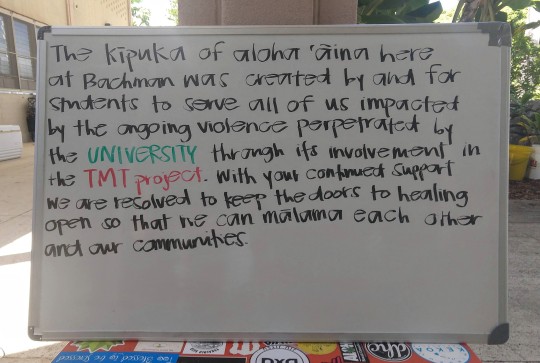
#KuKiaiMauna#malamaaina#alohaaina#kapualoha#RiseForHenoko#TogetherWeRise#IndigenousResilience#IndigenousRising#Kuleana#sukubun#KiaiKeKahaukani#UHManoa#Uchinaanchu#Shimanchu#solidarity#Kalaeloa#Kahuku
3 notes
·
View notes
Photo

Kiaikekahaukani: #Lā82
#MaunaKea: #Lā127
This past week/end was a turning point for the kia'i here at Bachman Hall, UH Mānoa. If you're on-island, please come join us tonight (Friday, 4:45-pau) for sunset 'aha and potluck to celebrate as a community!
See Update below, via Kia’i ke Kahaukani:
Aloha mai e nā hoa welo like. Mahalo nui to all of our ʻohana last week who donated their time, presence, and aloha during an emotionally charged situation for students at UH-Mānoa. Prior to this weekend the University locked students behind the glass doors, leaving them unable to join the ‘aha. This past weekend, with your support and assistance, the front doors to Bachman Hall were kept open.
The kīpuka of aloha ʻāina here at Bachman was created by and for students to serve all of us impacted by the ongoing violence perpetrated by the University through its involvement in the TMT project. With your continued support we are resolved to keep the doors to healing open so that we can mālama each other and our communities. Na wai lā hoʻi ka ʻole o ke akamai, he alahele i maʻa i ka hele ʻia e oʻu mau kūpuna. Our kūpuna demonstrate daily the ability to hold steadfast in kapu aloha, to heal through community, to unify in pule while facing difficulties of both the environment as well as the occupying government. We will ensure that these doors remain open in order to support each other and the communities that we represent.
To celebrate our community at Bachman and this season of change, we invite our ʻohana to join us tomorrow (Friday, 4:45pm-pau) in mele, manaʻo, and meaʻai. Students will provide ʻawa and limited food, potluck item encouraged if can. E nā hoapili e kūpaʻa mau, e holomua aku, e aloha nō kākou.
#KuKiaiMauna#togetherwerise#Kipuka#healing#UHManoa#BachmanHall#KiaiKeKahaukani#kiai#Oahu#Manoa#University of Hawaii#MaunaKea#protectthesacred#protectmaunakea#indigenousresilience#indigenousrights#indigenousrising
3 notes
·
View notes
Photo

11/8/2019 @ Bachman Hall, UH Mānoa:
Kia'i ke Kahaukani: Lā 75
Mauna Kea: Lā 120
Friday night, UH administration attempted to lock the students in again at Bachman Hall for the weekend. The University administration's strategy of giving ultimatums to clear out or be locked in over the weekend - cut off from supplies /community/ ability to participate in 'aha - seems to have a pretty clear aim to demoralize and silence these student kia’i and all the faculty, staff, and community that stand with them in support of Mauna Kea.
But this night would be different.
This time, the haumana kia'i at Bachman Hall sat in the doorway and informed the University administration that they cannot simply ignore their kuleana to the students and community.
Together with fellow students and community members who'd gathered in solidarity, they informed the University that "We are tired of being ignored, we are tired of being demeaned and we reject the University's attempts to determine the terms of engagement for Hawaiians - both on the mauna and at UH Mānoa. We remain committed to kapu aloha and our stand for the protection of Mauna Kea." Despite the hurtful words they hurled at the students, the admins ultimately walked away as students continued to stand their ground, resolute and embodying the spirit of kapu aloha.
For now, the doors remain open.
The haumana kia'i too, remain open - both open-minded and open-hearted - to continue dialogue with the University, whenever administrators are willing to uphold their promise to engage together with us in a collective problem solving process.

Chief Andy told us he believes everyone would be safer if they would "just go home and go to sleep..."
I couldn't help but think about how that's what UH administration wants both literally and metaphorically. Yet, there is a glaring oversight in this belief...
Business as usual here in Hawai'i is NOT safe for kanaka maoli.
The stealing of Hawaiian lands and continued use of its resources without consent does not make it safe to be kanaka on these islands.
And the role of the University in the continued threat and desecration of sacred spaces does not make these students or our communities safe.
So, while I'm not happy they are forced to take this stance, I am beyond grateful and inspired that we have each other as fellow students and community to stand (or in this case sit!) together.

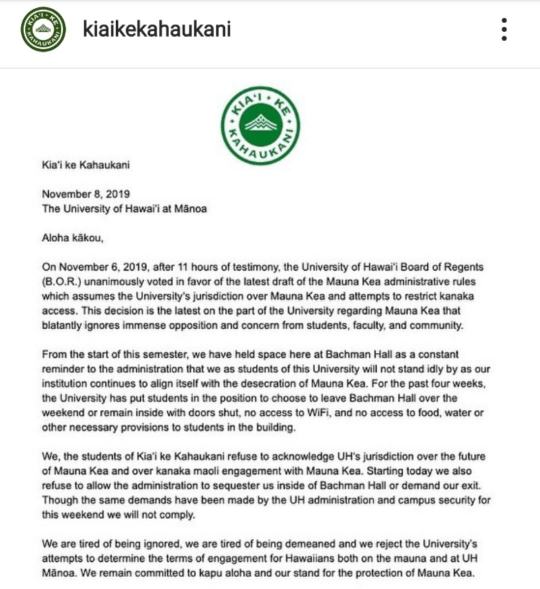
#KapuAloha#KapuAlohaAlways#KuKiaiMauna#TogetherWeRise#EAducation#UHManoa#aoletmt#indigenousrights#indigenousresilience#UH BOR#UHBoardOfRegents#UntilTheLastAlohaAina
0 notes
Video
Still wrapping my head and heart around the devastating fire at Sui gusuku / Shuri Castle.
Had intense dreams last night and woke to the sound of water flowing from Zuisen / Ryuhi, the dragon fountain that brings forth the spring waters that were once used to provide drinking water for the entire castle and its guests, including investiture envoys from China.
On a more personal note, this fountain also provided the spring water which my family once drew to distill amui / awamori for the Ryukyu court.
As the sound of that spring faded and I awakened to this reality, I still held an image which felt more like a memory than dream. I found myself at the steps of the Zuisemmon, adding my tears to the spring waters that began to overflow down the stone steps...
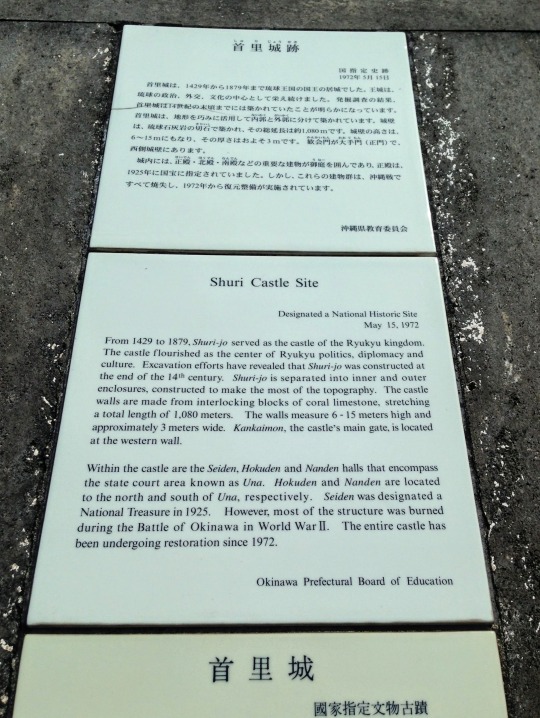

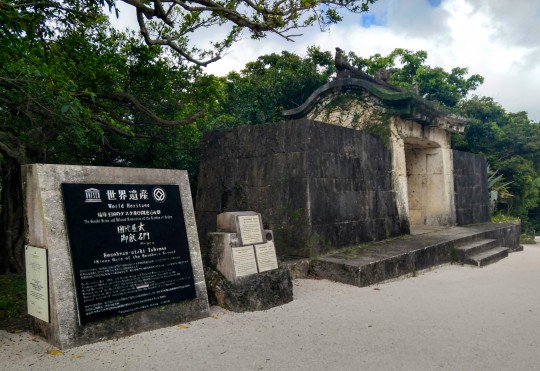


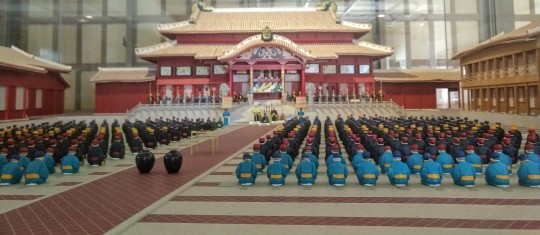


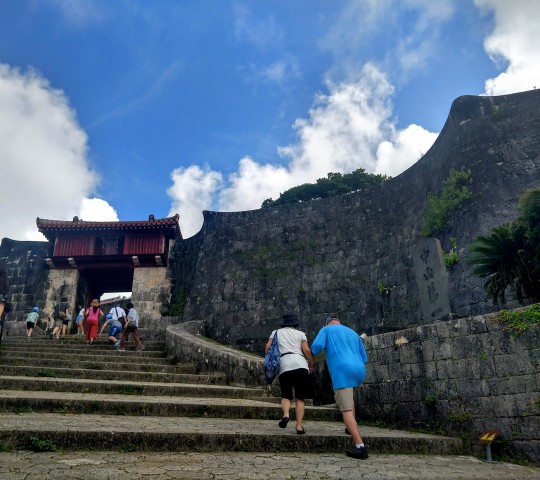

#Sui#SuiGusuku#gusuku#Shuri#Shuri gusuku#Zuisen#Ryuhi#amui#awamori#Ryukyu#LooChoo#Okinawa#Zuisemmon#Shuri Castle#ShuriCastle#IndigenousResilience#heartbreak#AuspiciousFountain#dragon#grief#mourning#rebuilding#TogetherWeRise#real history#unesco#ProtectAllSacredSpaces
39 notes
·
View notes
Text
A world with no word for “love”
While interviewing some folks about Language Endangerment, our discussions naturally touched upon how language reflects and reinforces the values and beliefs of a culture. Folks commiserated about what is lost when a language dies/is dying.
One example I was reminded of is that there isn't really a word for the English equivalent of "love" in "Chahta anumpa" (Choctaw language).
Modern dictionaries and younger language learners might say that "i hullo" means "(to) love" but some of us remember being taught this was traditionally closer in meaning to "caring" or "to care for." So the closest equivalent I could say when I wrote a beloveds eulogy was, "Chi hullo li na billia chih." (I will care for you forever.)
Love, however, was meant to be expressed through actions and not words.
#Language Endangerment#A Chahta sia hoke#Chahta#Chahta anumpa#Choctaw Language#Love#Language Death#Globalization#IYIL#Indigenous#Chahta isht atia
25 notes
·
View notes